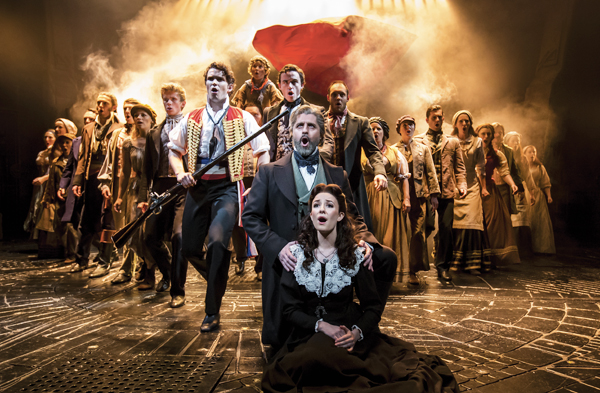
“It doesn’t work any other way Les Mis—and it’s a very delicate beast,” he says. “We don’t have click tracks, so there’s nothing to hide behind; it’s all about the cast, the band, and the FOH operator. So all we’re doing scene by scene is using the control groups, and just recalling what we need on those faders at any one point,” says Cobey, who started out on stage himself, playing in bands, before fusing his love of electronics and music, and hopping behind the console.
“Sure, I’m sending various MIDI messages out to other bits of kit to change for individual scenes, but beyond that, it’s line for line all the way through, and then I’m using all the DiGiCo’s internal effects and processing, which are great. All I’ve got outboard-wise is one external reverb.”
Cobey, who started out on a DiGiCo D5, says one of the key reasons for using DiGiCo consoles is their simplicity and configurability. “I love the SD7T; the fact anything can be anywhere means it really is a truly blank surface, and as a sound designer and as an operator, it’s extremely easy to move things around,” he says. “If you want things grouped together, it’s very simple; and let’s say you suddenly need to do a Sunday concert here, which is the day off for the Les Mis show, there will never be much replugging involved, just soft patching, so you can find it all very quickly. And being a Windows-based system, there are a lot of ways of doing it, so you can find your own little style when working with DiGiCo.”
Cobey is also utilizing QLab at FOH, which talks to the SD7T, and vice versa: “On this show, QLab is remarkably simple, really; it’s running a lot of sound effects. Each battle isn’t just a sound effect piped out of every speaker, though; it’s running a series of them at the same time, so they’re rebounding all over the auditorium to get that ‘in the middle of the battle’, epic feel going on.
“The SD7T is sending MIDI messages to QLab, to update and do what it needs to do, and then that comes back and updates the desk. This is so you can step through the sound effects, and the DiGiCO isn’t stepping through the scenes, it’ll just do the sound effects it needs to do, and when we’re ready to change a scene, QLab and the SD7T are always on the same page, so to speak.”
Beautifully Orchestrated
The Queen’s Theatre has quite a shallow orchestra pit, so a fair bit of the sound “just comes straight out”, Cobey says, which can make the intimate moments quite difficult to deal with.
“Once you get to a certain point, you really don’t have any control. Every instrument has a DPA mic on it – there are 25 DPAs in total in the percussion room, which is buried under the stage, so it’s very well isolated,” Cobey explains. “They’re such high fidelity microphones, and we’ve been using DPA here for years. We’ve got everything close miked with DPA 4061s, which are superb for capturing the detail of the instruments; and we’ve also got everything miked with overheads, which we use DPA 4011s for.
“The overhead mics are going straight to the surround mix,” he adds, “and that’s all part of Mick Potter’s design: making it bigger as opposed to making it louder.”
A plethora of string instruments are utilised on Les Mis: violin, viola, cello, bass, and a keyboard to back up the string section; and there are three woodwind players, who also double up on clarinet, flute, and sax. Furthermore, there is a trumpet player and trombonist, the latter of which doubles up on the french horn.
“They’re all on the DPA 4061 and 4011, in one combination or another, and we wouldn’t use anything else, as the combination of high fidelity and clarity is unbeatable,” insists Cobey. “I don’t crush much, compression wise, either; and sometimes, because of the arrangement of the show, I end up doing some backwards mixing: when it dies away, you still need to keep the ball in the air, as it were; it’s all about following the dynamic of the show, but also just keeping that energy up, so it doesn’t die away. The dynamics of the show are immense, and it doesn’t run like a typical musical. The principles singing these songs are all the same shape; it’s a sung through musical, so there’s never time to rest.”

